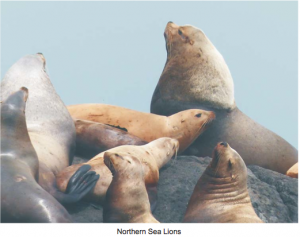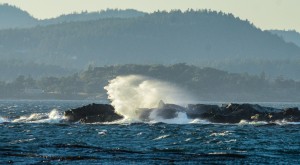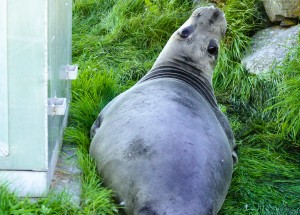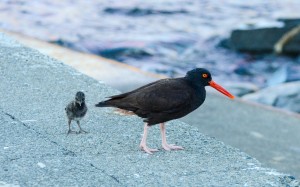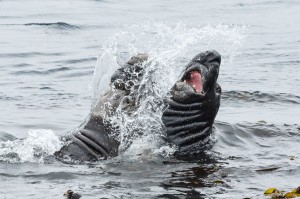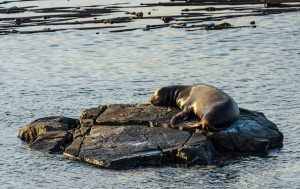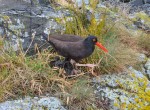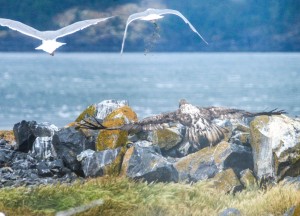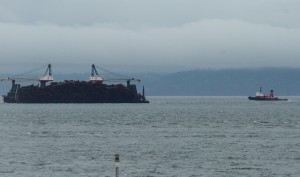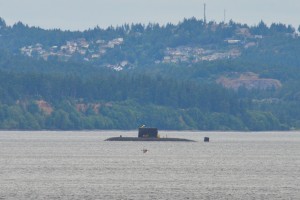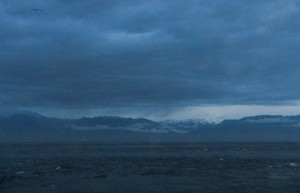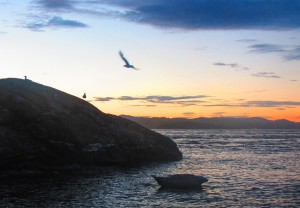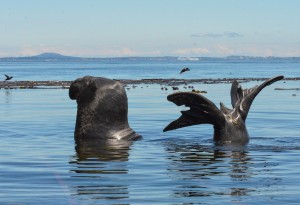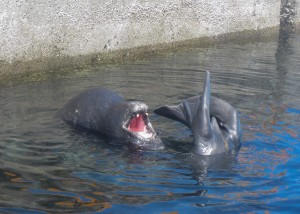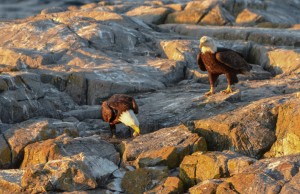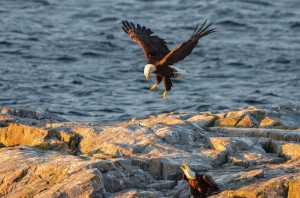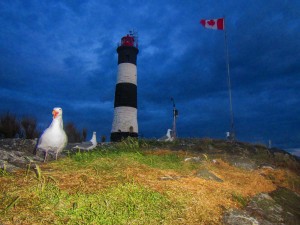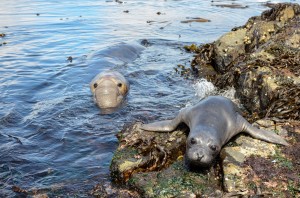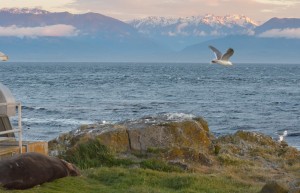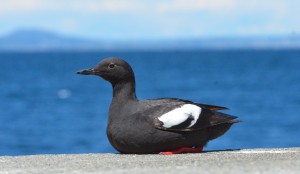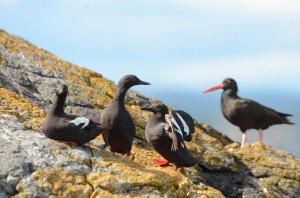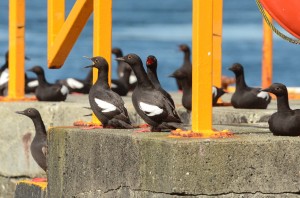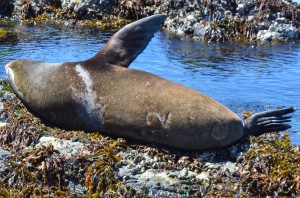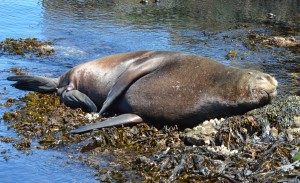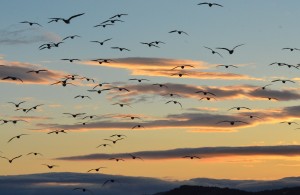Link to an article in the FoER Newsletter by Aziza Cooper on the Race Rocks Field Trip of Friends of Ecological reserves, May 12, 2013. http://ecoreserves.bc.ca/?p=17947
Strong Wind, DND, Coast Guard, Elephant seals, and Oystercatchers
The wind since Sunday evening has been very strong and even reached over 50 knots on Monday just before midnight. The photo shows North Race during a 30 knot wind. As the wind carries the water in the photo, it also sprayed the house windows which now are in sorely need of a clean.
During the winds, the Coast Guard paid a vist.
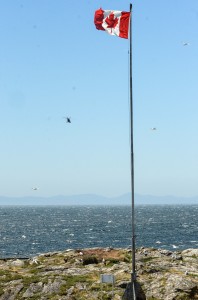
Coast Guard helicopter passing by a quick visit to the island, hovering over the helicopter pad for several seconds without landing and then taking off again. It looked like it was having trouble with its stability in the wind.
Another noise-maker for the past two weeks have been the blasts on DND. There have been as many as 5 or 6 per day on severals days since my arrival June 24.
A new female visitor came to the island Wednesday night. I noticed a juvenile elephant seal
Tuesday evening resting near the fire hose box. She was gone the following day but returned at around 22:30 when I ran into her with Chunk and Misery in the shallow water near the jetty while taking a water sample. Something that has been interesting upon her arrival is that Chunk and Misery have both changed their regular resting spots. Possibly just a coincidence, Misery has always been the one closest to the female.
On a bird note, the new oystercatchers have left the nest. The two have been exploring the jetty and surrounding area accompanied by two adults who become very vocal when any danger is in sight. The eggs on the opposite side of the island have yet to hatch.
Race Rocks: Legislative Gaps in Protecting Inshore Marine Protected Areas : Ken Dunham
Ken Dunham, a graduate of Pearson College UWC, now enrolled in a Law program at the University of Ottawa has submitted the following as a class assignment in Natural Resources Law, CML 1105H for Professor Stewart Elgie.
See the complete paper in this PDF: Race Rocks Legal Analysis-1
Introduction
Canada is a country of incredible natural beauty and ecological diversity, a significant portion of which has been protected under a system of national and provincial parks and other reserves. One might think that it would be a straightforward matter to similarly protect another unique ecological zone. Especially if it was small, located in a relatively remote location, and there was no suggestion that it should be used for anything else.
This paper explores why this is not so simple in the context of inshore marine areas. Canada’s constitutional / legal framework creates several gaps and overlaps with respect to the environment. The broader issue is not with any particular piece of legislation, but rather the sometimes-narrow context in which each was devised. This is further complicated by how the various statutory pieces fit together (or not) under the division of powers outlined in Canada’s constitution.
These issues can frustrate even the most straightforward project that attempts to carve out a little bit of nature for the benefit of future generations, as exemplified by Race Rocks.
———-
Conclusion
From a legal and constitutional perspective, the most comprehensive protection for Race Rocks would involve the Province of British Columbia transferring the islets and neighboring seabed to the federal government, followed by designation of Race Rocks as a Marine Conservation area under the CNMCAA.93 This would place stewardship of Race Rocks under one government and one minister.
The alternate approaches all involve significant legislative, constitutional, and ministerial gaps that leave major eco-systems at Race Rocks without complete protection.
An outright fishing ban within the boundaries of the Race Rocks reserve would greatly simplify enforcement and prosecution.
Regardless of the approach taken, continued involvement of the local First Nations is essential, given their Douglas Treaty fishing rights and various Aboriginal claims currently being negotiated. The First Nations perspective is that they should be one of three governments sharing decision-making authority as equals, and not merely labelled as just another stakeholder to be “consulted” (i.e. possibly ignored).
See the complete paper in this PDF: Race Rocks Legal Analysis-1
Oystercatchers Hatched, Chunk and Misery still sparring!
Mike left last week and I will be taking over for the next two months. My last shift was a year ago and it’s great to see how well Mike and Alex have taken care of the place.
Over the past number of days, Misery and Chunk have been pretty subdued with the exception of Thursday when both headed into the water and had a 6-hour long feud. There are no females on the island so my assumption is that Chunk is testing Misery’s role as alpha-male (which he’s proven to be in check).
The first sea lion of the summer has been hanging around on the main island and the southern rock.
Another first of the season are the newly hatched oystercatchers, pictured right. This nest is on the north side of the island and there is another on the south side that still has its 3 eggs intact.
For boat traffic, there averages 10-20 vessels per day in the reserve (weather depending). In the photo below, the gathered whale-watching boats to the west of Race Rocks implies a whale-sighting although it was too far for any good views from the island itself.
Another note on boat traffic, this morning four curious boaters from Pedder Bay Marina wanted to explore the island unaware it’s not for public use. I explained the rules of the reserve and sent the apologetic boaters on their way. Pam Birley took some snapshots on Camera 1.
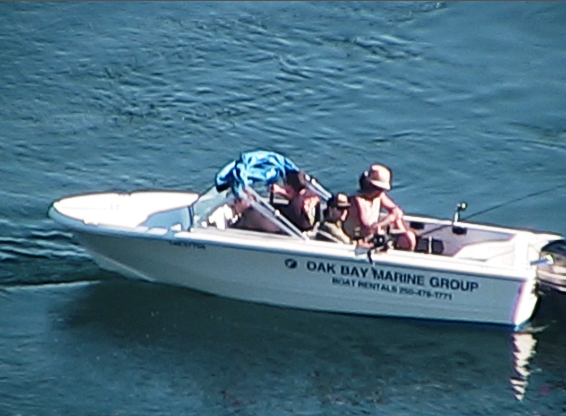
Seawater Data: Temperature and Salinity, June 2013
| Daily Seawater Temperature and Density Record Shore Station | |||||
| Time Zone: PDT | |||||
| Station: Race Rocks Lightstation | |||||
| Month:___June__________ | Year: 2013 | ||||
| ObserverLester B. Pearson College of the Pacific | |||||
| Continue reading | |||||
Header images on this website
The different horizontal header images that appear on this website and the log with the title “Race Rocks Ecological Reserve”, were made from images taken at Race Rocks and contributed over the past few years by the Ecoguardians of Race Rocks. A big thanks and acknowledgement to Ryan Murphy, Raisa Mirza, Adam Harding, Alex Fletcher, Julie Bowser and most recently many by Mike Robinson.
Gull colony self-protection measures!
It is my last day out here for a while and Julie is taking over again for the summer. I shall miss my elephant seal friends and a little less so the gulls. I got pooped on last night right on the nose! But as you can see by the picture I am not the only one to suffer an aerial strafing. Have a great summer everyone….
Darwin Core Archive Species identified in the Race Rocks Ecological Reserve in British Columbia
Garry Fletcher, Lester B Pearson College, 650 Pearson College Drive, V9C 4H7, Victoria, Canada;
Mary Kennedy, OBIS Canada, Bedford Institute of Oceanography, B2Y 4A2, Dartmouth
Corresponding author(s): Garry Fletcher (garryf(use the at sign) gmail.com), Mary Kennedy (mary.kennedy(use the at sign)dfo-mpo.gc.ca)
Received {date}; Revised {date}; Accepted {date}; Published {date}
Citation: Combination of authors, year of data paper publication (in parenthesis), Title, Journal Name, Volume, Issue number (in parenthesis), and doi of the data paper.
Abstract
XwaYeN (Race Rocks) is a showcase for Pacific marine life; including large marine mammals, seabirds, fish, invertebrates and plants. XwaYeN has a rich marine heritage and is culturally significant for several First Nations in the area. The waters surrounding XwaYeN (Race Rocks) are also an important nursery and recruitment area for Northern abalone, currently listed as a threatened marine species by the Committee on the Status of Endangered Wildlife in Canada (COSEWIC). Protecting this area will enhance the protection of this threatened species.
In 1980, the province of British Columbia, under the authority of the provincial Ecological Reserves Act, established the Race Rocks Ecological Reserve, which provides for the protection of the terrestrial natural and cultural heritage values (nine islets) and of the ocean seabed (to the 20 fathoms contour line). Ocean dumping, dredging and the extraction of non-renewable resources are not permitted within the boundaries of the Ecological Reserve.
Ecological Reserves are areas in British Columbia selected to preserve representative and special natural ecosystems, plant and animal species, features, and phenomena. Ecological Reserves provide the highest level of protection for the maintenance of physical and biological diversity while allowing for research and educational activities. Click here for more information on Ecological Reserves. Race Rocks Ecological Reserve was established to protect terrestrial, intertidal and sub-tidal communities that are extremely rich as a result of strong tidal currents. Continue reading
Ahhh June in BC
It always surprises me how long it takes for “summer” weather to arrive in BC. Today it is overcast, blowing 30 with driving rain, and 11 degrees (which feels like 7 with the wind chill). For Race Rocks weather records see this link.
3 male elephant seals and I are the only mammals on Great Race Island but this big female Harbour Seal calmly shared a lovely sunset with me at the sea side…
On a nice afternoon a few days ago Chunk was showing his flexibility by doing backbends and chewing on his hind-flippers.
Sensitive Oystercatchers
June is half over and I have about 10 days before Julie comes out to take over for the summer. I am trying to get some painting done in the dry and relatively windless spells, but one of the issues I am facing is trying not to disturb the oystercatchers nesting near the top of the ramp by the majority of railings. They immediately leave the nest when I get anywhere near, and won’t return til I am well clear. I worry about the eggs cooling too much, so I scrape the rails for 10 minutes then depart for an hour… Fortunately I have lots of time on my hands! Meanwhile only a couple juvenile e-seals remain and just as well because Misery’s curiosity is quite terrifying to them. Here one scrambles up the rocks to escape.
The Pigeon Guillemots are nesting in the larger cracks in the rocks; another reason to keep a low profile and limit my wandering around the island. They are adorable little birds!

